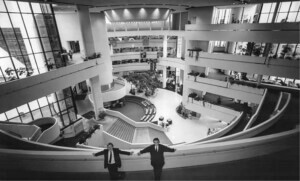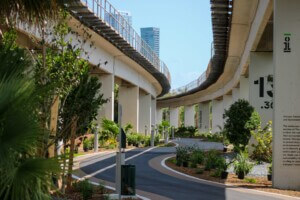Paved Paradise | Henry Grabar | Penguin Random House | $30
As I write these words, the clock is ticking. Just outside, a parking meter stands guard over my Prius, a blinking-green evil eye warding off pesky parking tickets. This is the third coffee shop I’ve visited today. The first didn’t have any parking, and the second charged $10 for parking, so I spent 15 minutes cruising around Santa Monica looking for a place to write. I have exactly two hours to write before I must vacate my space to make way for the next paying customer.
Until recently, this was exclusively how most thought of parking: superficially, selfishly, and with reluctance. Within local government, on-street-parking management filled out the lowest ranks of the civil service. Off-street-parking management fared little better, tainted by corruption. Among architects, the thankless job of designing lots and garages trickled down to junior staff. A self-respecting academic wouldn’t have been caught dead thinking about such a lowly subject.
That is, until Donald Shoup published The High Cost of Free Parking in 2005. Against a backdrop of apathy and antipathy toward the subject, Shoup dared to give parking the attention it deserves: The trouble with parking isn’t that there’s too little, but that there is far too much of it. The trouble with parking isn’t that it’s “free,” but that its high costs are hidden from drivers. Almost two decades later, Paved Paradise, a new book by Slate writer Henry Grabar, continues the parking revolution, and it’s now poised to go mainstream.
Grabar’s subtitle promises “How parking explains the world,” and it certainly has no trouble explaining how parking broke the American city. Over the course of the 20th century, Americans bought cars en masse, with little notion of where they would put them. The result was a mess: Streets quickly went into cardiac arrest, clogged up by endless rows of double-parked cars and drivers hunting for a spot. Many American drivers eventually gave up and departed for subsidized postwar suburbs, which were built from the ground up to accommodate cars.
In response, planners did two things: First, they undertook a radical program of building public parking, often clearing out historic neighborhoods to do so. Cities from Denver to New Haven mutilated themselves to compete with the suburbs, providing drivers with convenient and free parking while clearing away everything else. Second, they wrote minimum-parking requirements into zoning, forbidding the construction of any new structure without ample off-street parking. As a result, there are now an estimated eight parking spaces for every vehicle in the U.S.
All of this parking didn’t come cheap: By one measure, building a single spot in a surface lot can cost $20,000; and if it’s in an underground garage, be prepared to fork over as much as $80,000 per space. The result is that if parking mandates don’t make infill projects physically infeasible, they still often succeed in making them financially infeasible, especially where affordable housing is concerned. The cost of all that parking is baked into higher rents and home prices, more expensive goods and services, and lower wages. How’s that for free?
Paved Paradise deftly captures the extent to which such pseudoscientific parking mandates have deformed the American city. Nowhere is this truer than in Los Angeles, an early and eager adopter of the automobile. Entirely new building typologies emerged in response: Traditional storefronts gave way to strip malls, beloved cottage courts became illegal, and when these were replaced by dingbats, eventually those, too, were phased out. If not painted into surface parking, downtown L.A. lots that once hosted art deco office buildings and movie palaces now host parking podium towers, with garages separating workers from the public realm.
Meanwhile, there was a rather obvious solution to the problem of on-street parking congestion: Price it. Planners could have established prices such that there were always one or two spaces available on every block. Allowing prices to fluctuate based on location and time of day would have ensured that a spot is always available, eliminating the need to double-park or cruise. To make the cost politically palatable, those funds might have been reinvested into local improvements, like street trees and repaved sidewalks.

Of course, it’s easy to write a book picking apart U.S. city planning. What’s refreshing about Paved Paradise is that it captures a revolution that’s already well underway.
Since 2005, Shoup—a professor out of central casting, complete with a long scruffy beard and a stylish tweed wardrobe—has become a kind of cult leader, training a generation of city planners. Dedicated advocacy organizations like the Parking Reform Network have emerged to spread the parking reform gospel. Riding the recent wave of YIMBY activism that has remade zoning codes, parking requirements are now on the way out. In 2017, Buffalo, New York, and Hartford, Connecticut, eliminated them altogether. Fast-forward five years, and dozens of U.S. cities have done the same. Last year, California eliminated parking requirements near public transit nodes statewide.
Like Shoup before him, Grabar’s prose, sense of humor, and penchant for storytelling help to bring the subject alive—indeed, he may have written the first (and only) parking beach read. For readers new to the issue, the book will have a certain Death and Life of Great American Cities quality, revealing urbanity’s hidden rules and subliminal forces. For the seasoned urbanist, the book is a useful survey of the state of parking, rich with amusing stories and timely data. The text is accompanied by illustrations by Alfred Twu—the de facto artist of the YIMBY movement—playfully depicting the themes of the book.
Achieving the flow writers so desperately covet, I ultimately blew past the two hours of parking I had paid for while writing this review. Returning to my car, I was relieved to see no parking ticket tucked under my windshield wiper. Yes, I had just gotten away with theft. I stole approximately $2.50 from taxpayers. To be sure, I wouldn’t be caught dead stealing a $2.50 candy bar from a gas station or a $2.50 postcard from a bookstore. But what’s the problem? It’s just parking.
M. Nolan Gray is the research director for California YIMBY. He is the author of Arbitrary Lines: How Zoning Broke the American City and How to Fix It.











